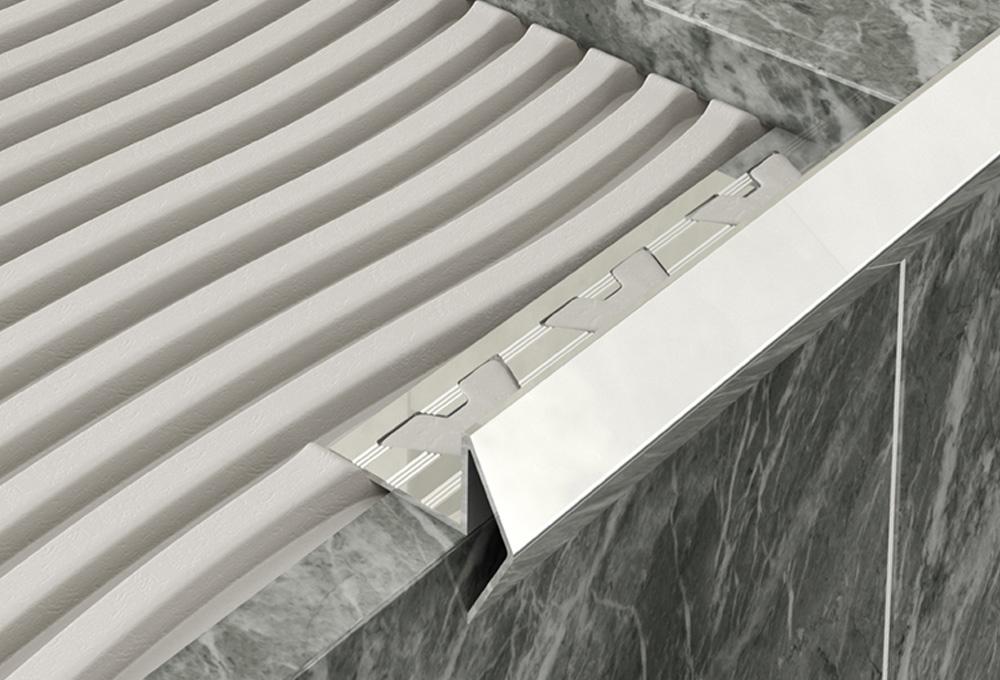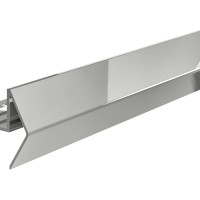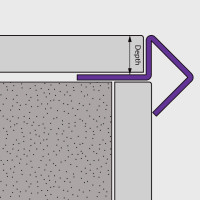
You need pdf software to read these documents. Download Adobe reader for free by clicking the icon on the left.
A stainless steel profile for finishing and protecting tiled step edges. Suitable for use in industrial applications. Features a perforated anchoring leg for securing in adhesive or mortar bond below the tiled surface.
This item is available in the following sizes
| Length : 2.5m | Product Code | |
|---|---|---|
| 8mm |  |
SPS080-STP |
| 10mm |  |
SPS100-STP |
| 12.5mm |  |
SPS125-STP |

You need pdf software to read these documents. Download Adobe reader for free by clicking the icon on the left.
Stainless steel, also known as inox steel or inox from French inoxydable, is a steel alloy with a minimum of 10.5%
chromium content by mass. Stainless steel is notable for its corrosion resistance.
Atrim manufacture a range of Stainless Steel profiles for protecting and finishing tiled corners and edges.
Recommended for use where there is a heavy level of wear or a high level of protection is required.
Atrim Straight Edge Profiles feature a perforated anchoring leg for securing in adhesive or mortar bond below the tiled surface.
Atrim profiles need to be checked at point of specification, for suitability of application in any given area. Chemical reaction, intermetallic corrosion and mechanical stresses must all be taken into consideration.
Stainless steel does not readily corrode, rust or stain with water as ordinary steel does. However, it is not fully stain-proof in low-oxygen, high-salinity, or poor air-circulation environments. There are various grades and surface finishes of stainless steel to suit the environment the alloy must endure. Stainless steel is used where both the properties of steel and corrosion resistance are required.
Stainless steel differs from carbon steel by the amount of chromium present. Unprotected carbon steel rusts readily when exposed to air and moisture.
Types of Stainless Steel
There are different types of stainless steels: when nickel is added, for instance, the austenite structure of iron is stabilized. This crystal structure makes such steels virtually non-magnetic and less brittle at low temperatures. For greater hardness and strength, more carbon is added. With proper heat treatment, these steels are used for such products as razor blades, cutlery, and tools.
Stainless steels are also classified by their crystalline structure:
Austenitic, or 200 and 300 series, stainless steels have an austenitic crystalline structure, which is a face-centered cubic crystal structure. Austenite steels make up over 70% of total stainless steel production. They contain a maximum of 0.15% carbon, a minimum of 16% chromium, and sufficient nickel and/or manganese to retain an austenitic structure at all temperatures from the cryogenic region to the melting point of the alloy.
• 200 Series—austenitic chromium-nickel-manganese alloys. Type 201 is hardenable through cold working; Type 202 is a general purpose stainless steel.
• 300 Series. The most widely used austenite steel is the 304, also known as 18/8 for its composition of 18% chromium and 8% nickel. The second most common austenite steel is the 316 grade, also referred to as marine grade stainless, used primarily for its increased resistance to corrosion. A typical composition of 18% chromium and 10% nickel, , is often used in cutlery and high-quality cookware.
Stainless Steel Finishes
Standard mill finishes can be applied to flat rolled stainless steel directly by the rollers and by mechanical abrasives. A final finish can then be applied to achieve the desired aesthetic appearance. Finishes include Bright annealed, Brushed finish, Satin finish, Matte finish, Reflective finish, Mirror finish and Heat colored finishes.
Maintenance
If treated or stored incorrectly, any grade of stainless steel may discolor or stain. To maintain optimum appearance, the surface should be cared for regularly.
During installation
The quality of installation affects the durability and lifespan of stainless steel. Therefore, it is important to make sure stainless steel is in good condition before installation. Normally, giving it a quick clean is enough prior to installation. However, if surface contamination is present, more attention is required. In fields such as aerospace, pharmaceuticals and food handling, an extremely high standard of cleanliness may be required, so extra care should be taken.
Routine maintenance
Maintenance is required to maintain the quality and appearance of steel. Depending on the environment, it is carried out between one and ten times per year. A proper maintenance routine significantly prolongs the life of stainless steel.
Maintenance tools
Abrasive cleaning tools should be avoided to prevent alteration of stainless steel finishes. Chloride-containing solutions, such as bleach, should also be avoided.
• Soft cloth and water: suitable for cosmetic issues and general cleaning
• Mild detergent: needed if stains cannot be easily lifted with water
• Glass cleaner: useful for removing fingerprints and similar stains.
Please Note: All technical specifications & information is supplied in good faith in accordance with our Terms and Conditions and to the best of our knowledge and intention.
| Dimensions | 2.5m cm |
|---|---|
| size | 10mm, 12.5mm, 8mm |
| material | Stainless Steel |
| finish | Stainless Steel |
| colour | Stainless Steel |





